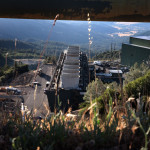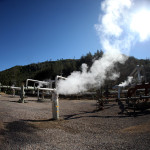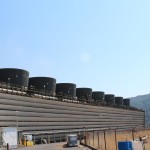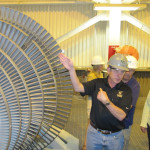Northern California is amazing. That’s a fact. Need proof? Just look around. We’ve got the Golden Gate Bridge, the Redwoods, half of Lake Tahoe, the largest geothermal energy facility in the world … What’s that? Yes, it’s true, referred to as The Geysers, we are right next door to one of the rarest geothermal energy landscapes on the planet.
Houston-based Calpine Corporation operates 14 of 16 power plants at The Geysers generating 725 MW of power, which is enough energy to power 725,000 homes or a city the size of San Francisco. The other two plants are run by Northern California Power Authority (NCPA) generating an additional 100 MW, totaling 825 MW of power being generated on the premises. The Geysers account for one-fifth of the green power produced by California, satisfying almost 60 percent of the average electricity demand in the North Coast region spanning from the Golden Gate Bridge to the Oregon border. They provide 5% of all of PG&E’s power supply, 100% of Sonoma Clean Power’s “Evergreen” program (plus 12% to their “Clean Start” program), and also provide power to Marin Clean Energy.
To get an idea of exactly where this place is, it’s sort of … nowhere. It’s in the Mayacamas Mountains, if that helps. “It is within no cities,” said Jim Kluesener, Regional Vice President, Geothermal for Calpine. The official address claims Middletown, which is still not quite right. The Geysers straddle 45 square miles of Sonoma and Lake counties and are located about 25 miles east of Cloverdale, 20-25 miles northeast of Healdsburg, and about 15 miles northwest of Middletown. So, there.
Not only are The Geysers in Middletown but, there are no actual geysers at The Geysers! They were misnamed by a grizzly bear hunter in 1847 and the name stuck. “A geyser would be a mixture of steam and water,” Kluesener explains. “We have what are called fumaroles: steam coming out of the ground.” Water boils at 212°, but underground at The Geysers temperatures reach 350-450° which is enough energy to keep the h20 as dry “superheated” steam. “Most geothermal resources don’t have enough heat to keep the h20 as a gas—as steam,” he says. “Most geothermal areas are hot water.” Kluesener wants to emphasize that when he later refers to the reservoir at The Geysers, “I’m not talking about a water reservoir—it’s a steam reservoir, underground; like groundwater, but it’s groundsteam under there.”
In 2011, Calpine received the California Department of Conservation’s Outstanding Lease and Facility Maintenance Award for Operations at The Geysers—for the tenth time. Calpine has focused on sustainability since their inception at The Geysers in 1998. “Today we have employees with Masters and PhD’s from Stanford and Berkeley who are helping us to sustain this for the long-term,” said Kleusener. “There’s a lot of pretty heavy science that is going into the long-term sustainability of this renewable resource.”
Sustaining a natural resource? It’s actually harder than you think. In fact, The Geysers gets about 20 million gallons of treated wastewater pumped into their facility every single day to keep the steam pressure where it needs to be. That’s 11-12 million gallons from the Santa Rosa/Rohnert Park/Cotati area, and 8 million gallons from Lake County. But … what about this “drought” we keep hearing about in California? Yep, still at thing, but this wastewater being used is not potable, and actually has no other place to go.
“The Santa Rosa wastewater treatment plant really wanted to avoid discharging to the Russian River,” said Kluesener. “There’s a lot of tourism, fishing, rafting, all kinds of things going on in the Russian River.” They have treated it to a cleanness that is officially legal to discharge into the river, but it still isn’t drinkable so they try and wait until there’s a fair amount of flow going down the river—generally only during a storm—so it would be diluted as much as possible. “They’re able to really have a great green environmental story by taking their treated water and sending it up the hill to turn it into renewable energy, rather than discharging it into the river.”
There’s a similar benefit for Lake County. Clear Lake is the largest natural lake in California (as Nevada also shares Lake Tahoe) and it is relatively shallow being mostly less than 20 ft. deep. As a tourist attraction, there are a lot of homes with septic systems right on the lake, said Kluesener. “The more we can get those folks to hook up and take [their wastewater] to a treatment plant, the less likely those … nutrients … are to get into Clear Lake and make it less than clear.”
In 1987, The Geysers peak output was approximately 2,000 MW, which is 1,175 MW more than today. In the 80’s, business was booming at The Geysers. Investors kept installing more and more power plants to maximize their profits. Of course, good things tend not to last. “You can never fully predict where you’re going to be at when you maximize your steam output,” said Kluesener. Each new power plant kept on producing, so why not build more? He explains that unlike today, where The Geysers consist of only two companies carefully working together with sustainability in focus, back then there were practically dozens of investors with money on the mind.
“They would just stake out their claim, like a gold rush, put as many straws in the ground as they could and pulled on it really hard so they could make as much money possible until it ran out,” said Kluesener. “Instead of trying to design something on how to best utilize the energy in the reservoir it was about how to make money, so without a major stakeholder in the operation, like [Calpine is] today, the longterm viability of the resource was in question.”
After the peak in ’87, production began to slowly trail off. 10 years later in 1997 the 29-mile pipeline from Lake County was completed, followed by the completion of the 40-mile pipeline from Santa Rosa in 2003, so the reservoir was able to remain stable after that. “That replenishing of the reservoir allowed the steam decline to basically stop,” said Kluesener. “The injection has kept it largely flat since then.” Plus, by the early 2000’s, Calpine had bought out pretty much everyone else at The Geysers except NCPA, he adds. “Now we have the opportunity to really look at this holistically and try to sustain this reservoir for the longterm.” And that’s just what they’ve been doing.
Care to see for yourself? The Geysers offer free tours and are happy to show you around the facility. “I love watching co-workers giving tours and really bragging about what we do up here,” said Kluesener. “It’s impressive. There’s a lot of great morale with the team.” With over 300 employees on the premises at The Geysers, there’s a lot to learn on the tour. There are several entrances for the tour, but coming from Middletown’s direction is highly recommended as that way you can start the tour by exploring their interactive visitor’s center—learn how a steam turbine generates electricity, see the size of those water pipes coming from miles away, touch drill bits, turn a crank and power a light bulb, all sorts of fun and interesting ways to educate yourself before the tour begins. Then you’ll hop on a chartered bus, walk through a power plant, get fairly close to the fumaroles, and if it’s a nice day you may even see some lovely views including the Sierra Nevada Mountains and Mount Tamalpais.
What does the future hold in store for The Geysers? Aside from maintaining their geothermal steam reservoir as well as their power plants, the oldest of which was built in 1971, they are still looking ahead. “We are currently involved in a lot of battery research, and even battery negotiations with PG&E and others,” said Kluesener. “We would be very interested in trying to help solve some of the California electrical grid problems.” He explains that there’s an oversupply of power at certain times of the day—the gas plants scale back while solar and wind are supplying most of the power, but have to be ready to fire up when the sun goes down; “If we can increase our storage, generally through batteries, then we can mitigate some of that need for the gas plants and we would be storing renewable energy while we’re at it.”
Nothing but good things happening at The Geysers. Pay them a visit if you can, learn about the process, and who knows? Maybe you’ll find yourself on a new career path. There’s plenty more information on their website, as well as a very interesting historical timeline. For further intrigue, visit www.geysers.com.
- Looking Down – Photography by Sharon Dawson, The Dawson Studios, Middletown, California
- Working – Photography by Sharon Dawson, The Dawson Studios, Middletown, California
- Steam!! – Photography by Sharon Dawson, The Dawson Studios, Middletown, California
- The towers
- Drill head
- Explaining how it works
Matt Larson is a writer/actor/comedian native to Vallejo who travels back and forth from Los Angeles way too much. He’s desperate for attention and urges you to follow him on all social medias @MarsLegstrong. He lives for likes, please keep him healthy.





















































